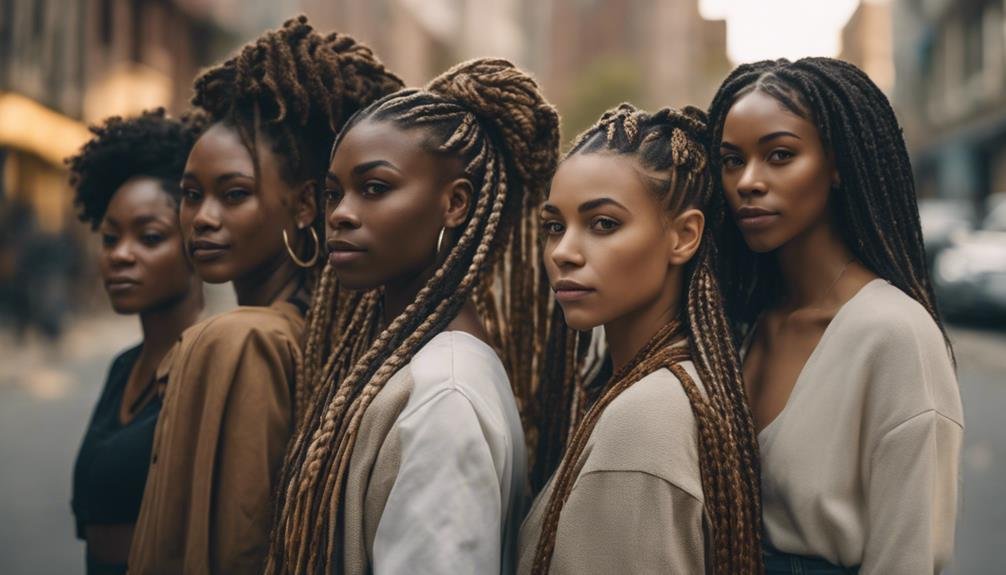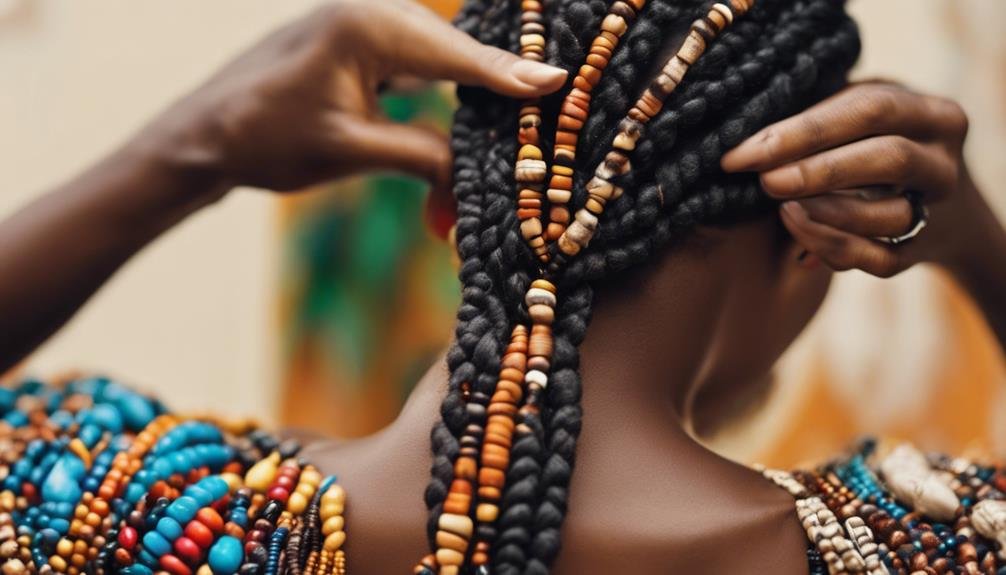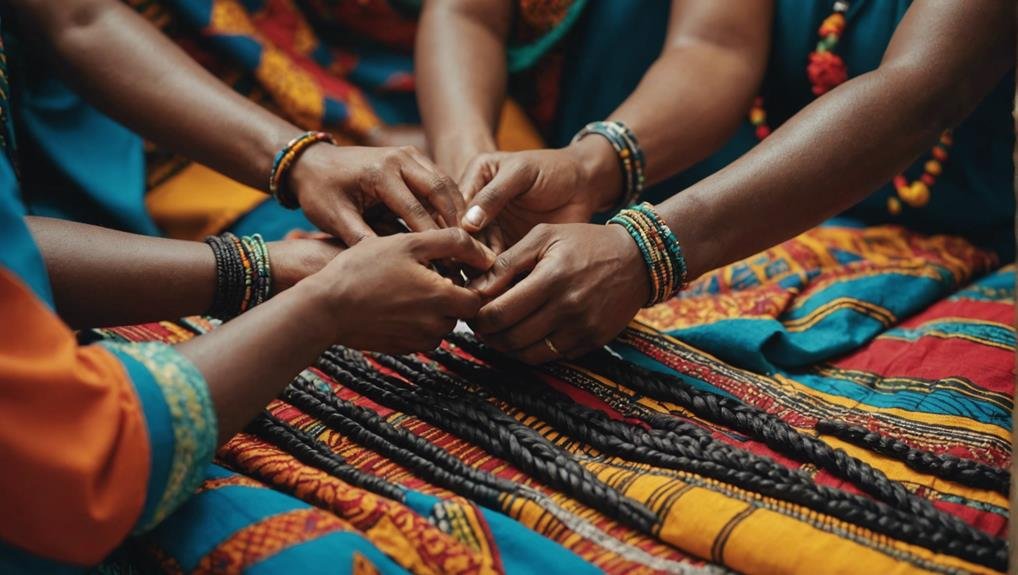You might not realize it, but when you see braids, you’re witnessing more than just a hairstyle; you’re observing centuries of history woven through the strands. Braids in African diaspora culture aren’t merely about aesthetics; they carry the weight of ancestral skills, stories of resistance, and symbols of unity. Each pattern and knot tells a story of survival and identity, reflecting both personal and collective journeys. As you reflect on their significance, consider how these hairstyles have been used as tools of empowerment and statements of cultural endurance. What might these intricate designs reveal about the resilience and creativity of those who wear them?
Key Takeaways
- Braids are a symbol of cultural heritage and identity within the African diaspora.
- They serve as a form of historical and cultural preservation.
- Braiding styles represent personal and communal narratives of resistance and resilience.
- Braids foster a sense of unity and solidarity among the African diaspora.
- They are a means of expressing individuality while honoring ancestral traditions.
Origins of Braiding in Africa
Braiding in Africa, tracing back to ancient civilizations like the Nok in Nigeria and the Mende in Sierra Leone, reveals a rich tapestry of cultural heritage and social significance. As you explore further into the continent’s history, you’ll find that braiding wasn’t just about aesthetics; it was woven into the very fabric of African societies. Each braid pattern holds a tale, a custom, a symbol of identity linked to social status, tribal affiliation, and even marital status.
Imagine walking through an ancient African village where each person’s hairstyle tells a story of their life. The intricate braiding patterns you see aren’t just for decoration. They signify whether someone is single, married, or of a certain social standing. In some cultures like the Fula in the Sahel region, women’s braids are adorned with silver and amber discs, enhancing their beauty and emphasizing the cultural significance of their style.
Braiding styles across Africa vary immensely, but the common thread is their role in cultural expression and identity. This practice, preserved over millennia, serves as a living history book, displaying the continuity and adaptation of African heritage through hair. So, when you see African braiding, remember, you’re witnessing a centuries-old tradition that goes beyond mere fashion.
Symbolism in Braiding Styles
In African diaspora culture, every braid pattern carries a deep symbolism, reflecting elements such as age, marital status, and social standing. You’ll find that these styles are more than just aesthetic; they’re a rich form of communication steeped in heritage and identity. Braids tell stories of cultural pride and resilience, weaving a continuous thread through generations.
| Braid Style | Symbolism |
|---|---|
| Cornrows | Connection to ancestral traditions; often signify unity and resilience. |
| Box Braids | Represent freedom and the power of self-expression. |
| Twists | Indicate both modernity and a deep respect for historical significance. |
These styles serve as a visual narrative of identity and resistance, a proof of the strength and creativity of the African diaspora. They’re not just part of a cultural outfit; they’re emblems of pride and survival, a direct linkage to ancestral traditions. As you carry these styles, you’re also carrying centuries of storytelling and resistance, showcasing a profound connection to your roots and a display of resilience against cultural erasure. Remember, each twist, knot, and braid is a chapter in the larger story of your heritage.
Braids as Cultural Resistance

Throughout history, braids have served as a powerful form of cultural resistance for the African diaspora. When tracing your roots back to the times of slavery, you’ll find that braids weren’t just about beauty; they were a lifeline to your heritage and a quiet rebellion against efforts to strip away your ancestral identity. Each braid carried the weight of resistance, a silent affirmation to the strength and resilience of your ancestors.
Braids were more than just a hairstyle; they were a complex language of solidarity and survival. Here’s how:
- Communication: Braids were used as covert tools for communication among enslaved Africans, helping to plan escapes and spread messages.
- Preservation of Culture: Despite oppressive systems, braiding helped preserve African traditions and cultural practices.
- Symbol of Resistance: They visually represented defiance and resilience against cultural assimilation and oppression.
- Reclamation of Identity: Braiding is a way for you to reclaim and celebrate your African roots, affirming your identity.
- Expression of Solidarity: Sporting braids fosters a sense of solidarity and connection within the African diaspora community.
Evolution of Modern Braiding
Modern braiding styles have transformed, incorporating techniques like box braids, Senegalese twists, and faux locs to both protect and express cultural identity. These braided styles, serving as protective styles, have become integral in maintaining natural hair health and showcasing cultural pride. The evolution was markedly influenced by the Black Power Movement, which emphasized the beauty and significance of natural hair and culturally inspired styles.
During the 1990s and 2000s, mainstream media’s recognition brought these styles into the limelight, enhancing their cultural significance. This exposure has helped solidify their status not just as fashion statements, but as potent symbols of identity and resilience in the face of societal challenges.
Moreover, the introduction of discrimination protection laws marked a pivotal moment for braided styles. These laws acknowledge the importance of such hairstyles in African diaspora culture, offering a shield against cultural discrimination and empowering individuals to wear their hair proudly without fear of prejudice.
Despite setbacks like cultural appropriation, the resilience of braided styles continues to echo the community’s ongoing fight for recognition and respect. These styles aren’t just about aesthetics; they’re a declaration of cultural heritage and an act of political resistance.
How do Traditional Braids Hold Meaning in African Diaspora Culture?
Reviving traditional braids cultural impact is evident in African Diaspora culture. These intricate hairstyles are more than just a fashion statement; they hold deep cultural meanings. Traditional braids serve as a connection to African heritage, embodying a sense of identity, pride, and unity. By embracing and celebrating these hairstyles, individuals within the African Diaspora community reclaim their roots and preserve their cultural heritage.
Braiding and Identity Expression

Braiding powerfully expresses identity within the African diaspora, weaving together elements of cultural heritage and personal pride. When you choose a specific braided style, you’re not just making a fashion statement—you’re also revealing layers of personal and communal history. This form of identity expression is a profound aspect of the cultural fabric, deeply rooted in generational traditions and tribal affiliations.
Here’s what your choice in braids could be saying about you:
- Cultural Heritage: Each pattern has a story, connecting you to a lineage of skilled craftsmen and women whose hands have woven not only hair but also the tales of their ancestors.
- Personal Identity: Braids can be a canvas for self-expression, showcasing your unique style and personality through intricate designs.
- Tribal Affiliations: Certain styles can indicate your family’s region or tribe, linking you to a specific community within the vast tapestry of the African diaspora.
- Social Status: Historically, different styles could signify age, marital status, or social standing, acting as a visual communication tool.
- Craftsmanship: The complexity of braids reflects the artistic and technical skills passed down through generations, highlighting an enduring respect for precision and creativity.
As you wear your braids, you carry a piece of history, an art form that transcends mere aesthetic, embodying the strength and spirit of the African diaspora.
Conclusion
As you explore the world of braiding, you’re not just embracing a hairstyle; you’re connecting with a profound legacy. Braids aren’t just about beauty; they’re a confirmation of resilience, a form of cultural preservation, and a bold statement of identity.
By choosing to wear these styles, you keep ancestral traditions alive, celebrate your heritage, and stand in solidarity with the African diaspora. So, every braid you sport is a powerful echo of history and a personal declaration of pride.

